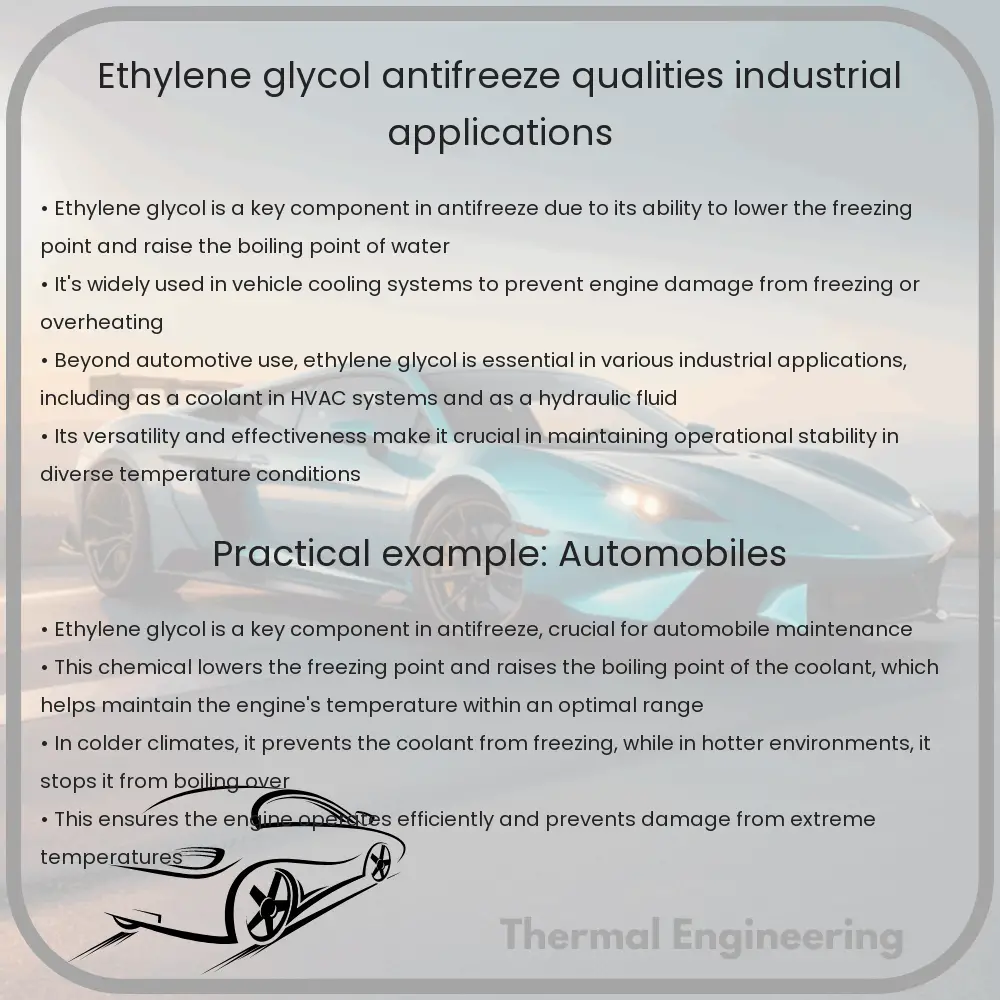Learn about Ethylene Glycol’s role as an essential antifreeze ingredient and its wide range of industrial applications.

Understanding Ethylene Glycol: The Essential Ingredient in Antifreeze
Ethylene glycol (C2H6O2) is a commonly used chemical compound in various industrial applications, the most notable being its role in antifreeze formulations. This colorless, odorless, slightly viscous liquid is prized for its ability to lower the freezing point of water, which helps in preventing the formation of ice and, consequently, the bursting of pipes and engines due to freezing temperatures.
The Antifreeze Qualities of Ethylene Glycol
At the core of ethylene glycol’s functionality as an antifreeze is its high boiling point and low freezing point. Ethylene glycol prevents freezing of water and overheating of the engine through its thermal properties and ability to disrupt the formation of ice crystals. This makes it an essential component in cooling and heating systems, particularly in automotive antifreeze where it protects the engine components at both high and low temperatures.
- Freezing Point Depression: When mixed with water, ethylene glycol serves to lower the freezing point of the mixture. This is critical in colder climates where water could freeze and expand, causing damage to car engines or plumbing systems.
- Boiling Point Elevation: In addition to lowering the freezing point, ethylene glycol elevates the boiling point of water, allowing higher coolant temperatures without the risk of boiling over, which is crucial in maintaining engine performance.
- Corrosion Inhibition: Modern ethylene glycol-based antifreeze solutions also include corrosion inhibitors that protect metal parts of the engine and cooling system against corrosion, further enhancing their lifespan and efficiency.
Industrial Applications of Ethylene Glycol
Beyond its critical role in antifreeze products, ethylene glycol finds extensive use across a diverse range of industrial applications:
- Manufacture of Polyester Fibers: Ethylene glycol is a key ingredient in the production of polyesters, particularly polyethylene terephthalate (PET), used in making everything from plastic bottles to polyester fabrics in the textile industry.
- Deicing Fluid: It is also employed as a deicing fluid for windshields and aircraft, owing to its freezing point depression properties. This application ensures optimal performance and safety under icy conditions.
- Heat Transfer Fluids: In industrial settings, ethylene glycol is used in heat transfer fluids to transport heat in cooling and heating systems, such as in HVAC systems or solar panels.
- Hydraulic and Brake Fluid: The chemical properties of ethylene glycol make it suitable for use in hydraulic brake fluid formulations, where it serves as a medium that conveys force within the brake system.
The versatility and efficiency of ethylene glycol in these applications highlight its importance in modern industrial and automotive systems. However, it is also important to handle ethylene glycol with care, as its ingestion can be toxic to humans and animals. Adequate safety measures and proper disposal are essential to prevent its harmful effects.
Conclusion
Ethylene glycol is a key compound in both the automotive and industrial sectors due to its effective thermal and chemical properties. From its use in antifreeze to its role in polyester production, this chemical facilitates numerous applications that enhance the functionality and safety of everyday products and systems. Understanding its properties helps in appreciating how it serves as a backbone for many modern technologies and industrial processes.